THE BIKINI SPIDER
T-boy Babineaux was lying on his death bed and the doctor told him he could die any minute. Suddenly T-boy smelled the wonderful aroma of his wife’s gumbo. Using the last of his energy, he stumbled to the kitchen and was leaning against the counter tasting from the pot when his wife yelled, "Babineaux! Shame on you! You know that gumbo is for the funeral."
As predicted, Babineaux died and the next day his wife sent his obituary to the newspaper. It read, "Babineaux died." The newspaper called his wife and explained that for the same amount of money she could add up to 100 words more of details. After much thought she corrected the ad and the next day it ran reading, "Babineaux died yesterday. Boat for sale!"
Of all warm water dry fly patterns, possibly the most renowned is the spider. Originally it was the “sponge” or “rubber” spider. Thanks to today’s EVA foam, you can build a much better spider. Sheet foam and interlocking mat foam and flip flop foam are all ethylene vinyl acetate (known as EVA). EVA is particularly good for making flies because it has a consistent finish, is generally unaffected by temperature, is stress-crack resistance, and resistant to UV radiation. Although it has a strong smell initially (sometimes unpleasant), it has little or no odor after a short airing out. [EVA is also used in adhesives and glue sticks, sports cleats, clingy plastic wraps and in certain biomedical engineering applications and manufacturing processes. Very versatile stuff.]
Nuclear testing on the Bikini Atoll (Marshall Islands) in 1946 is thought to have obliterated all life on the atoll. That year, Louis Réard, a French engineer in the lingerie business, named his new swimsuit for the bomb test site. While men all agree that bikinis are “the bomb,” the reason Réard chose that name is not clear, but, thank goodness, he did introduce the first bikini. Back on the atoll, if there were survivors, the likelihood is they were insects. Much like the Chernobyl Ant, the Bikini Spider suggests how native species may have morphed into a more spectacular form. Best of all, like a bikini, it takes few materials that are easily put on. Preparation of materials is the longest part.
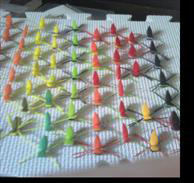
Materials:
- Hook: Size 8 to 12 2x long
(Try Mustad #3261 at lurecraft.com which are $3.75/100) - Thread: flat waxed nylon
- Body: EVA foam – sticky back sheets
(Michaels or Hobby Lobby or WalMart sells 5½ x8 inch 20 packs for about $7) - Legs: Round rubber legs
(jannsnetcraft.com sells 10 color packs 1"x12" for $3.89) - Glue: CA glue (brush on)
PREPARING THE BODY
STEP 1: Cut a 1' strip off of three 2mm sticky back foam sheets. Stick the sticky side of two foam sheets together (be careful because this is instantly permanent) and then stick a third sheet onto the back of one of the first two sheets making a 6mm foam sandwich. Unfortunately, some sheets stick better to the non-sticky side than others, so, alternatively, you can use CA glue to adhere the third sheet (which, obviously would not have to be sticky back and actually sticks better with CA glue if it is not).
NOTE: You can also use 6mm foam sheets to do this (www.craftsuppliesforless.com) but then the fly will be a single color. Decorating with a Sharpie is always an option here.
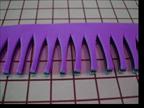
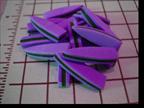
STEP 2: Take a pair of curved tip scissors (Dr. Slick 4.5" hair scissors work well) and make a cut starting at the edge of the foam. The cut will curve. Turn the scissors around (or turn over the foam) and make a second cut intersecting the first cut at the tip. You will now have a tapered body (flat at the front end leading to a pointed end). It may be obvious, but the farther from the start of the first cut you make the second cut, the larger the spider body. As little as 1/16th of an inch can make big difference. On an 8" strip you should average 12-14 bodies.
TYING THE SPIDER
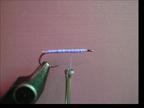
STEP 3: Put a size 8 Mustad #3261 hook in the vise and cover the entire shank with thread matching the bottom color of the foam. Overwind and stop the thread about 1/4 inch from the hook eye.
NOTE: You need not spend a lot of money for expensive hooks. The Mustad 3261 works fine. Never heard of a 3261 – that’s because it’s a cricket hook at https://www.lurecraft.com.
STEP 4: Coat the top of the thread covered shank with CA glue.
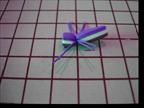
STEP 5: Press the foam body down on the glue covered thread placing the flat end of the body just behind the eye of the hook.
STEP 6: Take two tight wraps over the foam at the point where the thread is hanging down. This will create a segmentation of the head and body.
STEP 7: Tie in two strips 1" long of rubber leg materials on each side Madam X style. Trim the legs evenly. Whip finish around the eye of the hook and coat bottom of fly (over the thread) with Sally Hanson.
NOTE: This pattern resembles https://www.flyanglersonline.com/features/bobboese/111008.php because all spider patterns are basically the same (some are intended to attract fishermen more than fish). Using either pattern, and with a little practice, you may easily tie a dozen an hour. Taking 30 bluegill on a bikini spider before it starts to show wear (usually the legs give out) is common.
HOW TO FISH THE SPIDER:
As explained in that previous article: “What the facts suggest is that a novice fisherman buying a sponge spider has the good luck to purchase a generic insect fly, that represents nothing in particular, and particularly not a spider. The sponge spider may look like a wasp, or bee, or caterpillar, or beetle, or maybe like nothing in nature at all. Bluegill probably doesn’t consider that something that only sort of looks like something to eat might be something else.”
Any spider is intended to be fished slowly. Cast out to a likely spot and twitch the line, then wait. Twitch and wait. And again. Strip and move the spider 6-12 inches then twitch and wait. As soon as you are out of the likely spot, recast and repeat the process. Bluegill and other sunfish often gather together in one location (except for the spawn when putting a spider on any bed is almost guaranteed to provoke a strike). If you catch a bluegill, others are probably in the vicinity. After 3-4 failed casts, pick another spot, but don’t restrict yourself from returning to the first spot.
For more great info, check out:
Beginning Fly Tying | Intermediate Fly Tying | Advanced Fly Tying.
